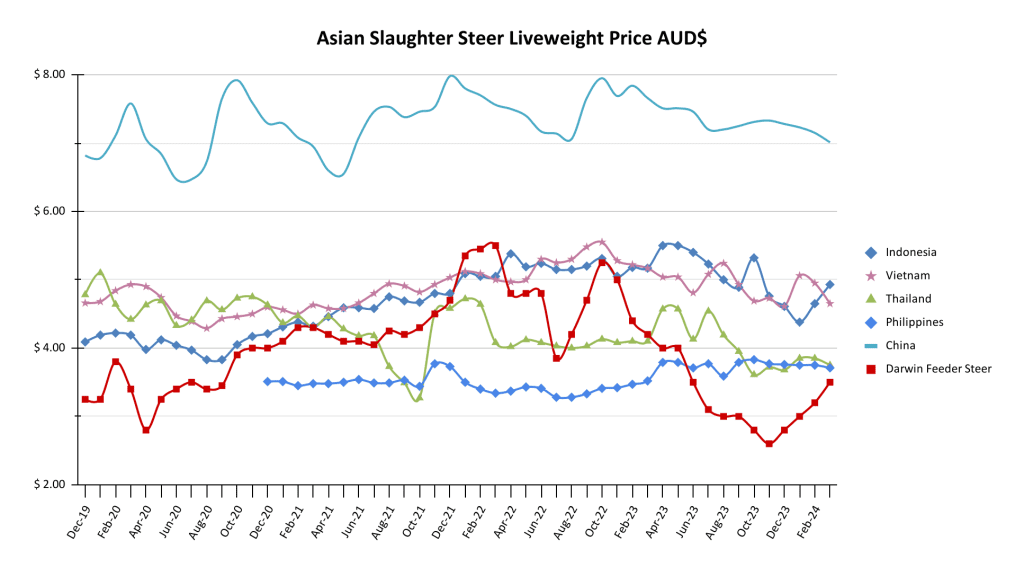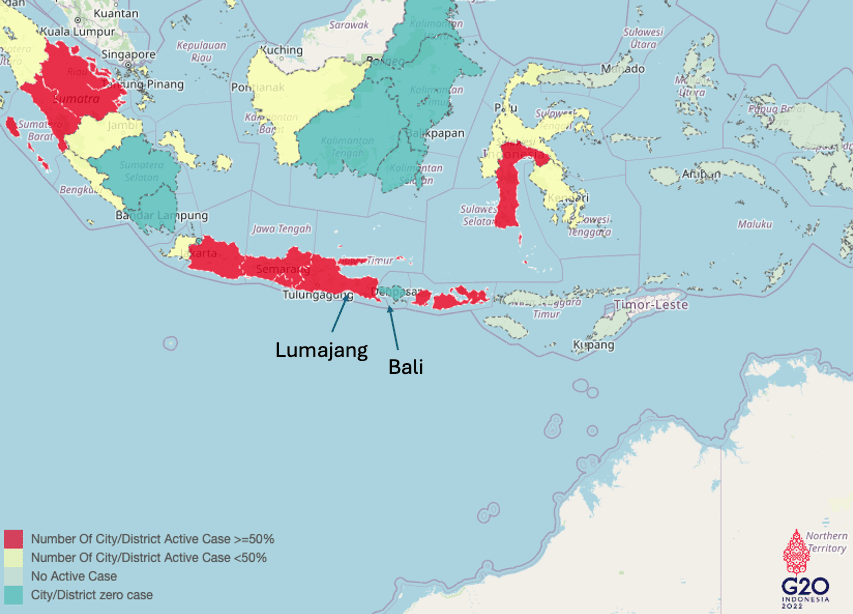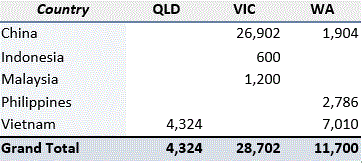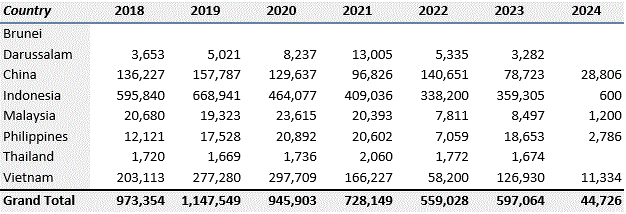
123rd Edition: March 2024
Key points:
- Indonesian importers stock-up after recent pause in supply due to import issues.
- Comments by Indonesia’s new President-elect Prabowo Subianto raise questions about how his incoming government views Australia’s role in cattle supply.
- General increases in meat and food staple pricing across the region continue to put pressure on consumer spending.
Regional Trends and Overview
Disease impact in cattle and other livestock in the region continues to be a headline issue for most countries. African Swine Fever continues to wreak havoc in the region with the Philippines particularly hard hit.
Prices of pork in both the Philippines and Vietnam have spiked in the last two months, putting pressure on household budgets in countries where pork is a common protein source.
LSD and FMD continue to cause headaches for importers of Australian cattle in Indonesia, with outbreaks in some feedlots still occurring.
A hangover effect from the Malaysian government’s decision to temporarily ban Australian cattle from being imported to the country last year is a new lengthy quarantine requirement for Australian cattle, which is apparently making imports almost impossible for slaughter cattle.
A cultivated meat producer here in Singapore, which had its products approved and available to consumers, has stopped production, following a general trend for meat alternatives globally.
This seems to be another good example of well-intentioned businesses being launched based on the desire to make change, without understanding what their consumers want.
In conversations I have had around consumer meat choices in the region the cultivated meat products seem to fall in a kind of no-man’s-land. If consumers want the taste of meat but don’t want to eat real meat for ethical reasons, they choose tofu or tempeh which can be easily incorporated into many local dishes.
The market segment of people who want something that taste and feels like meat, is not real meat, but also isn’t tofu or tempeh, seems to be a fraction of a fraction of people.
Indonesia: Steers AUD $4.93 / kg live weight (IDR 10,340.51 = 1 AUD)
Cattle importers are reporting an increase in the prices of imported feeder cattle from Australia and a diminishing stock of cattle in importer feedlots. This situation raises the risk of a surge in domestic beef prices during Ramadan and Idulfitri in 2024. The current market price for beef is around Rp135,000($13.05 AUD) per kilogram from Rp 134,000 per kg last month in average. According to traders, the price of beef may potentially rise to Rp140,000 per kilogram or more during Ramadan, expected to commence on March 12, 2024. The carcass price has reached Rp96,000 per kilogram from Rp94,000 per kg last month. However, the lack of a surge in consumer demand due to rising prices across staple commodities means beef sellers are willing to sell beef with a smaller profit margin at their stalls. To fill the gap left by the recent import permit issues importers are now bringing in slaughter weight animals to top up their inventories leading into the Indonesian religious festival season.
The Indonesian Presidential election has seen Prabowo Subianto, the Defense Minister since 2019, claim a decisive victory with 58% of the vote, finally succeeding after two previous attempts. This triumph on February 14 also celebrates Gibran Rakabuming Raka, son of the outgoing President Joko Widodo, as a victor. Prabowo, aiming to transform Indonesia, proposes an ambitious agricultural agenda, including opening four million hectares for farming and expanding biofuel production. His success is generally seen as positive for agriculture and the cattle industry. His plans, however, come with significant financial promises, such as a free school meals program costing up to $29 billion USD, raising questions about funding strategies.
Prabowo and his team made comments during the election suggesting that 1.5 – 2.5 million head of dairy cattle would need to be imported to meet the free meal program’s dairy requirements, but concerningly for Australia, suggested India and Brazil as potential sources for the cattle. Interesting considering Australia has a reputation as a reliable supplier of dairy cattle, right on Indonesia’s doorstep. There are plenty of reasons, both from a commercial and biosecurity standpoint, of why imports from India or Brazil would be very difficult to pull off, but it is obviously notable when the president-elect voices it himself. A government-decreed effort to support the importation of cattle from Australia’s competitors would challenge Australia’s position as the supplier of feeder and breeder cattle. Prabowo won’t take office until later this year which means we still have to wait some time to see what his policy agenda will mean for Australian exports.
On February 29, 2024, Indonesia’s Vice President K.H. Ma’ruf Amin inspected halal slaughter processes at Taylor Preston Limited in New Zealand, emphasizing halal certification and Indonesia’s goal for beef self-sufficiency despite current import reliance. He made comments about the potential for large-scale cattle production in Sulawesi, Kalimantan and East Nusa Tenggara (NTT).
Sulawesi faces a high alert for Jembrana disease, a lethal retrovirus, with a recent outbreak in North Gorontalo. Jembrana is a little known retrovirus that is generally only found in Indonesia. It is especially deadly to local Bali cattle breeds with mortality rates of around 20%. It has been a known issue for local cattle since the 1960’s, with outbreaks occurring every few years.
Tracking the spread of LSD in Indonesia can be challenging, with conflicting reports of how far east it has reached. Recent Indonesian media reports show outbreaks in Lumajang Regency in East Java, an area less than 150 km from Bali. FMD is prevalent as far east as Nusa Tenggara, as reported by the Indonesian Ministry of Agriculture. It is curious that the Ministry continues to report 0 cases of FMD in Bali, despite cases being reported on islands to either side of the popular holiday destination. The Ministry’s widespread vaccination programs appear to be helping to reduce mortality numbers but of course have little impact on the continual spread of both diseases.
Source: Crisis-Center PMK: Ministry of Agriculture Indonesia – FMD reported cases map
Vietnam : Steers AUD $4.65 / kg live weight (VND16,335.9 = 1AUD)
Vietnam celebrated its Tet New Year holidays in early February. This is normally a period of peak processing for Australian cattle and was again this year with abattoirs increasing their kill of Australian cattle by around a third during the period. Prices peaked shortly before Tet and then fell off afterwards, another annual trend for Australia’s second biggest live cattle market. Imported Thai cattle are trading at a premium to Australian cattle at about 79,000 VND($4.83 AUD) which is the norm, though there is a bigger than usual gap with the post-Tet lull in trading activity.
Beef importers are reporting significant rise in beef prices for some cuts to around 10% and a significant shortage of US and Canadian beef in the market. Food Hotel Vietnam occurs from the 19-21st March so there should be some opportunities for Australian exporters to explore market opportunities. I should be at the event on the 21st for those interested in connecting.
Over the coming weeks, under Impetus Animal Welfare, I will also be conducting training for animal welfare, meat quality and will discuss environmental protection with abattoir workers and owners. It forms part of an Australia Vietnam Economic Grant (AVEG) to build capability and investment between Australia and Vietnam. It will amongst other things use the Livecorp VR captive bolt training. While breeding and productivity remain key issues, it is the limited capability and capacity of the abattoir sector in Vietnam which limits any maturing of the sector. Fewer higher volume abattoirs with improved standards is imperative to ensure competitiveness with imported products. As well as securing the trade for Australian livestock when prices are competitive.
Philippines: Slaughter Steers AUD $3.71 / kg liveweight (P. 36.99 = 1AUD)
Like most countries in the region the Philippines has seen a general increase in the price of food staples. In wet markets and supermarkets alike, beef knuckle has been between at P. 580/kg($15.69 AUD) and P. 630/kg($17.05), respectively. Local cattle prices in Mindanao are still pegged between P. 130-145/kg($3.65-$3.92 AUD) liveweight, and the hot carcass meat price is approximately P. 260/kg($7.03 AUD). It is important to note that these figures are for cattle bred and traded within Mindanao, not Australian imports.
Feeder Steers Darwin $3.50 Townsville $3.30
There was a rush of live cattle ships headed to Indonesia in the last few weeks, finally able to move after import permits were released in mid February, 6 weeks later than expected. Several of those vessels, and others which had been waiting at anchorage, headed to Townsville to source heavier cattle to fill the six week gap left in Indonesian importer feedlot schedules. Livex steer prices out of the North have increased as buying got back underway in a rush and caught up with the domestic market price increases seen in January.
2024 Year to January figures for cattle sea freight across Asia by state (Feb not released) from DAFF figures:
Year 2024 to January figures for cattle sea freight comparison across Asian markets (Feb not released) from DAFF figures:








HAVE YOUR SAY